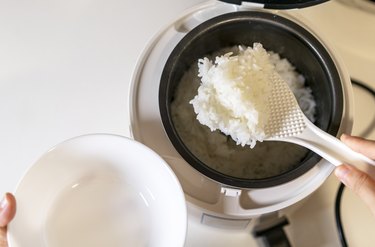
Preparing a pot of rice is a deceptively simple process. It's not especially difficult — billions of people do it successfully every day — but there are plenty of ways for it to go wrong. You can eliminate many of the common frustrations by purchasing a rice cooker, which will turn out good-quality rice with minimal fuss. Rice sticking to the rice cooker is one minor quibble with these handy appliances, but there are several ways to minimize the problem.
Prevent Rice Sticking to the Rice Cooker
Video of the Day
Before you start cooking, you can do a few things to reduce the likelihood of your rice sticking.
Video of the Day
- First, most long-grain rices benefit from a quick rinse before you cook them. Friction rubs some of the starch from the rice as it's stored and shipped, and this powdery coating of starch makes the rice stickier. As an added benefit, well-rinsed rice cooks up lighter and fluffier. It's also less likely to boil over and leave a sticky mess on your lid or countertop.
- Spraying the cooking pot with pan spray, or rubbing it lightly with butter, can also help keep the rice from sticking to your rice cooker. It's especially helpful if your cooker doesn't have a nonstick lining, or if the lining is scratched and worn.
- Use the correct amount of water for your rice. Brown rices typically need more; white rices require less. The more water you use, the softer your rice becomes and the likelier it is to stick to the bottom of the cooker. Consult your cooker's manual, or the printed instructions on your rice, for details
Rest Your Rice After Cooking
The great charm of rice cookers lies in their one-button convenience. Start the machine, walk away, and come back when the rice is finished. What happens afterward, oddly enough, is often the key to whether or not rice sticks.
When the rice is done, leave it in the cooker to keep warm for at least 10 minutes or even as long as a half-hour. The steam that's still trapped in the rice will disperse throughout the grains, and any stuck-on rice at the bottom of the pot will gently loosen as it absorbs the steam. This resting time also provides an opportunity for the rice's starches to cool and re-establish their structure. When you open the rice and fluff it with a fork, the grains will hold their shape instead of breaking or collapsing into a gummy paste.
Preserving Your Rice Cooker's Non-Stick Surface
Rice is more likely to stick to a cooker with a scratched surface, whether or not it originally had a nonstick coating. Use a wooden or nylon spoon, or a silicone "spoonula," to remove the finished rice from your cooker. Metal utensils will scratch the surface. When you're scrubbing out the cooking pot, use nonabrasive cleansers and nylon scrubbing pads rather than metal scrubbers. Your cooker will last longer, and you'll spend less time coping with stuck-on rice.
Rice Makers that Brown the Bottom
In some cultures — Iranian cuisine, for example — rice is encouraged not only to stick, but to become crisped and brown. Creating this golden layer, the "tah dig," is considered the test of a cook's skill. Some rice cookers are manufactured specifically to meet this demand, and in those machines your rice will always stick and brown at the bottom. If you can't learn to love the browned-on rice, you'll need to trade up to a different machine. Ask friends and read reviews, or choose a machine with "fuzzy logic" circuitry that controls doneness and prevents browning.